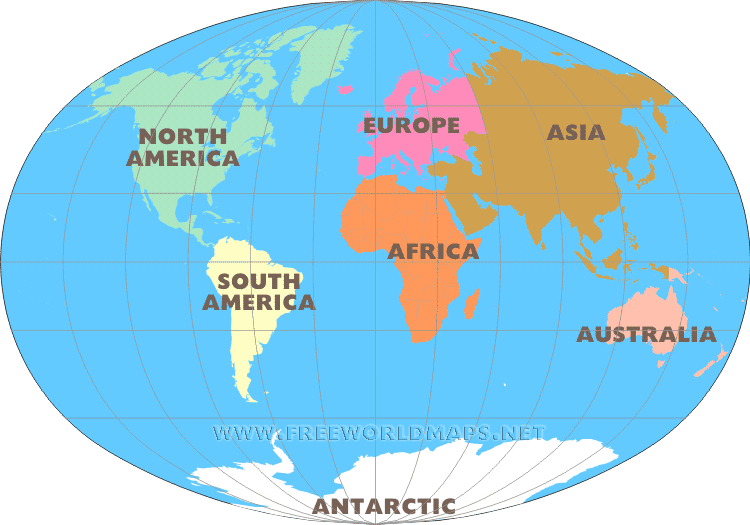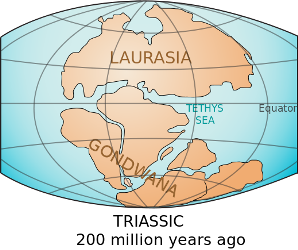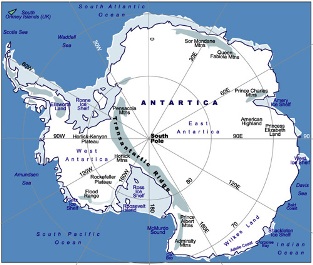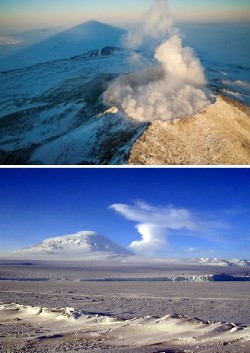And You Thought You Knew Them All!
There are seven continents in the world, right? You can find them on a map. You can even name them in order of size: Asia, Africa, North America, South America, Antarctica, Europe, Australia. Ta-dah!
http://www.viewpointcorp.com/printable-map-of-the-7-continents/
So, what is this Gondwana? Oh, you think I’m taking about a paranormal or science fiction novel. No? Well, what the heck?
Once Upon A Time, A Long, Long, Long Time Ago....
There was just one mass of land on the earth. [I said it was a long time ago.]
By the early Paleozoic, about 500 million years ago—give or take a million years or so—that single land mass had separated into two supercontinents—Gondwana (or Gondwanaland), the more southerly of the two, and Laurasia.
500 million years is a hard concept for me to get my mind around, since I can't even remember if I took my pills this morning. None the less, much greater minds than mine say the theory of continental drift is supported by legions of scientists researching in a variety of fields over many years. Who am I to question?
Below is a depiction of what these legions of scientists think the land masses looked like during the Triassic period about 200 million years ago.
| Maps from Wikimedia Commons the free media repository |
As you can see from the map, at the time Gondwana extended north of the equator. A good portion of the land was in warmer and wetter climate zones, and was host to a huge variety of flora and fauna for many millions of years. This is confirmed both by the geology of the continent of Antarctica and by the discovery of fossil remains of plants and animals.
Continents On The Move
How do continents move around? Very slowly. LOL. Sorry!
The generally accepted theory of plate-tectonics is that the earth's surface is broken into a number of shifting slabs or plates about 50 miles in thickness, which move relative to each other above a hotter, deeper, more mobile zone at average rates of a few inches a year. Most of the world's active volcanoes are located along or near the boundaries between shifting places.
In the early Jurassic era [184 million years ago], the supercontinent of Gondwana began to break up, accompanied by massive eruptions of basalt lava, and East Gondwana began to separate from Africa. South America started its drift westward, and about 120 million years ago India began to move northward.
Yada-Yada-Yada! Drift, drift, drift!
It’s a little fuzzy as to when all the changes took place, and complicated as to why, since no one was around to record it and everyone has a slightly different take on the time. But here's the best I can do.
540 to 200 million years ago
During the Cambrian period, Gondwana had a mild climate. West Antarctica was partially in the northern hemisphere. During this era large amounts of sandstone, limestone, and shale were deposited. East Antarctica was at the equator, where sea-floor invertebrates and trilobites flourished in the tropical sea. During this period, plant life was dominated by fern-like plants which grew in swamps. Over time these swamps became deposits of coal.
180 million years ago
Gondwana, consisting of Africa, Antarctica, Australia, India and New Zealand begins to break up.
100 million years ago
Forests made up of ferns and conifers still cover most of Gondwana.
96 million years ago
Australia and New Zealand split from Antarctica; Antarctica goes it alone.
70 million years ago
Antarctica, still enjoying a semi-tropical climate, continues to drift south.
60 million years ago
Antarctica develops a cool temperate climate (like the UK)
50 million years ago
There is much geological activity as the Trans-Antarctic mountains are uplifted from sea level cutting across Antarctica from coast to coast.
40 Million years ago
The first large ice caps form as Antarctica settles into its position over the south pole.
38 to 26 million years ago
Antarctica accepts the fact that it's going to be a rugged individualist and becomes the coldest and windiest place on earth. Since then it has more or less stayed put.
Will The Real Antarctica Please Stand Up
Geologically speaking, I think we can expect things to remain about the same during our lifetime. So what have we got besides the fifth largest continent on earth, with zero permanent population, that doesn’t belong to anyone? The coldest, driest, and windiest place on earth.
Until recent years, it's been hard to study the geology of an entire continent covered with two miles of ice, but remote sensing is giving us an idea of what the land is like underneath.
West Antarctica resembles the Andes and was created by uplift and metamorphism of sea-bed sediments. The most common rocks are volcanic andesite and rhyolite formed during the Jurassic period.
There is a major active rift valley between West and East Antarctica, said to rival the Grand Canyon in size. The rift is still active with slow movement of West Antarctica away from East Antarctica. The continent was relatively flat before the glaciers started carving deep valleys 34 million years ago. Now, much of the continent is under two miles or more of ice that has been there for millions of years.
The continent is divided into unequal eastern and western portions by the Transantarctic Mountain chain, which is about a million years old. That’s fairly recent when we’re talking about 500 million years. The eastern portion is a platform about 1,600 feet above sea level. The West, which lies south of South America, is lower than in the east and in some places below sea level. The highest peak, Vinson Massif, is 16,000 feet above sea level. Mt. Erebus is an active volcano which is 12,447 feet located in East Antarctica.
Okay. You guessed it. I’m going to Antarctica! Just one little part of it [the peninsula that is closest to Cape Horn, the tip of South America], but it’s still Antarctica. Some of the comments you receive when you say you are going to Antarctica.
● "Oh, yes. Isn’t that where the glaciers are melting?”
● "Why would you want to go there?”
● “I’d love to go with you and see the polar bears.”
● “Are you going skiing?”
● “Oh, do you have relatives there?”
Sometimes I wonder about our education system. (One of the few "animals" that live in Antartica (besides whales, penguins, and seals) are tardigrades. I had to look that one up myself. You'll be getting a blog about them in the future and they will play a role in the murder mystery I'm writing which takes place at the research station at the South Pole.
Lost more to come on Antarctica. Till then.
Resources
http://www.scienceclarified.com/everyday/Real-Life-Earth-Science-Vol-2/Geologic-Time-Key-terms.html
http://en.wikipedia.org/wiki/Geology_of_Antarctica
http://en.wikipedia.org/wiki/Antarctic_Peninsula
http://www.divediscover.whoi.edu/antarctica/history.html
http://www.austhrutime.com/antarctica_geological_history.htm
http://en.wikipedia.org/wiki/Gondwana
http://www.ehow.com/info_8564656_description-plate-tectonic-theory.htmlhttp://www.infoplease.com/ipa/A0001765.html
http://www.divulgence.net/axis%20shift%202.html
http://www.scientificamerican.com/article/climate-change-has-shifted-location-north-south-poles/
http://geology.about.com/od/geotime_dating/a/Geologic-Time-Scale-All-Periods.htm
http://www.wisegeek.org/what-is-continental-drift-theory.htm#didyouknowouthttp://www.scientus.org/Wegener-Continental-Drift.html
http://www.coolantarctica.com/Antarctica%20fact%20file/History/history_of_the_land_geological-timeline_of_antarctica.htm




 RSS Feed
RSS Feed